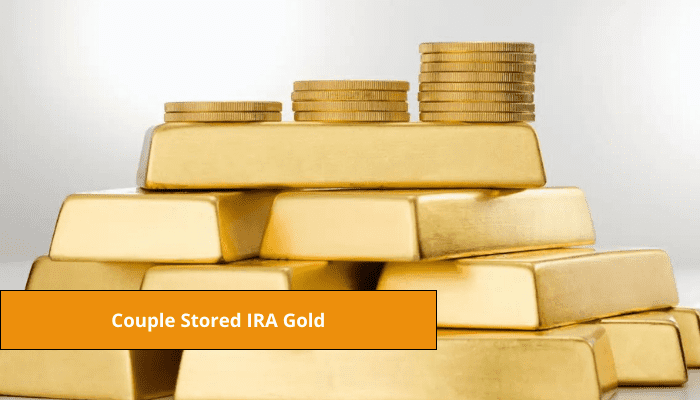- Our content is independently written and reviewed by trusted reviewers & fact-checkers.
- Your information is never sold. We can earn money by connecting you with top Gold IRA Companies. Learn how our reviews work.
- Want to learn more? Meet our authors and explore our editorial policy.

“In this world, nothing can be said to be certain except death and taxes.” is the famous and much-quoted quip attributed to Benjamin Franklin.
Of course, the inevitability of death has remained unchanged since Franklin’s time, and we still pay taxes. But on the positive side, today’s modern investors now have ways to make their investments more tax-efficient.
One such vehicle is the gold IRA, in which you can invest in gold and other precious metals and take advantage of certain tax benefits.
By holding physical gold in an IRA, your assets can be shielded from the ravages of inflation and market volatility. But as with any investment, the best place to start is by first considering the tax implications.
In this article, we’ll explore the IRS rules surrounding gold IRAs and how investing in precious metals can impact your tax situation.
Table of Contents
Highlights of What You’ll Learn about Gold IRA Tax Rules
- You’ll discover the three types of Gold IRAs available so you can choose the best option for your retirement savings strategy.
- We’ll clarify the IRS requirements for precious metals held in a Gold IRA, ensuring you invest in approved coins and bars from trusted sources.
- You’ll gain insights into the roles and responsibilities of custodians and depositories in maintaining a compliant Gold IRA, as well as your own duties in record-keeping and tax reporting.
- We share the pros and cons of Gold IRAs, helping you weigh the potential benefits (like tax-deferred growth and inflation hedging) against the drawbacks (such as RMDs and early withdrawal penalties).
- We compare Gold IRAs to other precious metal investments to better understand their unique tax advantages.
How Does a Gold IRA Work?

A gold IRA, or Individual Retirement Account, is a retirement investment vehicle where you hold physical gold and other precious metals – silver, platinum, and palladium.
Gold IRAs have all the same tax benefits as traditional IRAs.But unlike traditional IRAs, which typically invest in stocks, bonds, and mutual funds, a gold IRA gives you the opportunity to diversify your retirement savings with tangible assets.
The process of setting up and maintaining a gold IRA is pretty straightforward. First, you’ll need to choose a custodian for your gold; these companies specialize in managing self-directed IRAs and can help you with the purchase and storage of your precious metals.
You’ll also need to select an approved depository to store your physical gold and other metals securely.
Once your account is all set up, you can fund your gold IRA with cash, which you can then use to purchase gold, silver, platinum, or palladium in the form of coins or bars.
The IRS has specific guidelines regarding the purity and type of precious metals that you can have in a gold IRA. We’ll discuss these requirements shortly, but don’t worry; your custodian will ensure your investments meet them.
Types of Gold IRA
There are three types of gold IRAs you can invest in – traditional gold IRAs, Roth Gold IRAs, and SEP Gold IRAs.
Traditional Gold IRA
Let’s start with traditional gold IRAs. With this type of self-directed IRA, you can invest in gold and other precious metals while enjoying the same tax advantages of a traditional IRA. You’ll benefit from tax-deferred growth and will only pay taxes on the investment gains of your gold once you start taking distributions after you retire.
Roth Gold IRA
With Roth gold IRAs, you get a different set of advantages. You contribute after-tax dollars, so you won’t get a tax deduction upfront. Once you reach retirement age, you can withdraw your contributions and earnings tax-free as long as you’ve held the account for at least five years.
SEP Gold IRA
If you are self-employed or a small business owner, then you’ll want to look at SEP gold IRAs. You can contribute higher limits than traditional or Roth IRAs and scale up your retirement savings. Like traditional IRAs, contributions to a SEP gold IRA are tax-deductible, and withdrawals in retirement are taxed as ordinary income.
Eligible Precious Metals

As we mentioned previously, your custodian will guide you as to what precious metals you can or can’t hold in your gold IRA, but it’s best to be in the know anyway.
Eligible Precious Metals and Purity Requirements
IRS-approved Metals for Gold IRAs – are Gold, Silver, Platinum, and Palladium.
| Metal | Minimum Purity |
| Gold | 99.5% |
| Silver | 99.9% |
| Platinum | 99.95% |
| Palladium | 99.95% |
Approved Mints and Refiners
Not all precious metals are treated the same. Precious metals standards have been set in place to allow them to be sourced only from IRS-sanctioned mints and refiners to be eligible for inclusion in a Gold IRA. This prerequisite guarantees that the metals’ authenticity, purity, and quality meet the required high standards.
The approved providers include, but aren’t limited to:
- National Government Mints
- Accredited COMEX/NYMEX Refiners
- London Bullion Market Association (LBMA) Members
- ISO 9000 Certified Refiners
A few examples of IRS-approved precious metal coins include:
Gold
- American Eagle coins
- Canadian Maple Leaf coins
- Australian Kangaroo/Nugget coins
Silver
- American Eagle coins
- Canadian Maple Leaf coins
- Austrian Philharmonic coins
Platinum and Palladium
- American Eagle coins
- Australian Koala coins
- Canadian Maple Leaf coins
Custodian and Depository Requirements
Investing in a Gold IRA doesn’t just involve selecting IRA-eligible gold but also choosing gold IRA custodians and depositories that meet IRS compliance requirements.
Your chosen custodian will be responsible for assisting you in setting up your account and that all paperwork and transactions meet IRS standards. They’ll then buy the IRS-approved metals on your behalf. Custodians are also responsible for reporting contributions, distributions, and any taxable events related to the Gold IRA to the IRS and for sending you annual statements.
The IRS also mandates that physical precious metals held in Gold IRAs are stored in a secure, approved depository. These depositories’ safekeeping where your gold is held will be fully insured and have the highest-level security measures in place.
Tax Reporting and Compliance

Custodians can take a lot of the heavy lifting off your plate when it comes to managing your Gold IRA, but at the end of the day, it’s up to you to make sure you’re following all the tax rules.
Don’t worry, though – your custodian will be there to guide you through what they’ll handle and what you need to take care of yourself.
Role of Custodians in Reporting
Custodians of Gold IRAs are responsible for several reporting duties, including:
Issuing Form 5498 – Custodians report contributions made to an IRA, including Gold IRAs, using IRS Form 5498. This form is sent to both the IRS and the account holder, usually in May, to report contributions for the previous tax year.
Issuing Form 1099-R – When distributions are taken from a Gold IRA, custodians use Form 1099-R to report the distribution to both the IRS and the investor.
Investor Responsibilities
Despite the custodian’s role in managing the Gold IRA and handling certain reports, as an investor, there are responsibilities that you need to be on top of.
You should keep your own detailed records of all transactions within your Gold IRA, such as purchases, sales, and distributions. With this documentation in hand, if you have any discrepancies with the IRS, it will be much easier to resolve.
When taking distributions from a Gold IRA, income on your annual tax return must be reported. The information on Form 1099-R from the custodian will assist in accurately reporting these distributions.
Investors and custodians alike must adhere to IRS deadlines:
IRA Contributions – Contributions for a specific tax year can usually be made up until the tax filing deadline of the following year (typically April 15).
Distributions – Required minimum distributions (RMDs) must start by April 1, following the year in which the account holder reaches age 72 (previously 70½ before the SECURE Act).
Pros and Cons of Gold IRAs
| Pros | Cons |
| The value of your gold investments can grow tax-deferred within a traditional Gold IRA | Traditional Gold IRAs are subject to RMDs starting at age 72, meaning you must start taking taxable distributions from your account annually |
| With a Roth Gold IRA, your qualified withdrawals in retirement are tax-free if you meet certain conditions. | if you withdraw funds from your Gold IRA before age 59½, you may be subject to a 10% early withdrawal penalty in addition to income taxes on the distribution. |
| Gold has historically been viewed as a hedge against inflation. Holding it within a tax-advantaged IRA might help protect your retirement savings from inflations erosive effects. | If you decide to take physical possession of your gold from a Gold IRA, it will be treated as a taxable distribution and may be subject to higher long-term capital gains taxes compared to other investments. |
Comparing Gold IRAs to Other Precious Metal Investments
Gold ETFs and Mutual Funds
These are the two most common alternatives to gold IRAs. With both types of funds, you can invest in physical gold without owning the precious metal itself. Shares can be easily bought and sold on stock exchanges, giving them more liquidity than physical gold. Still, gold ETFs and mutual funds come with their own set of fees and expenses, which can eat into your returns.
Physical Gold Held Outside of an IRA
Another option is to hold physical gold outside of an IRA. This gives you the tangible satisfaction of owning gold coins or bars. Technically, you can store your gold at home or in a safe deposit box at a bank. The downside? You miss out on the tax advantages of gold IRAs, and the security and insurance becomes your responsibility. And as the IRS deems gold as a collectible by physically holding it, you can be taxed up to 28% on your investment gains.
Mining Stocks
If you want to invest in the gold industry without directly owning the metal, mining stocks can be appealing. These investments can still give you exposure to the gold market, but higher returns than physical gold are potentially on the table. But they also come with higher risks, as the performance of these investments is tied to the success of individual companies and the overall mining industry.
Essentially, the best option you have for tax savings on gold investments is a Gold IRA.
How to Get Started with a Gold IRA
OK, now you’ve discovered the benefits and tax implications of a Gold IRA, the next question you’re probably wondering about is how to get started. That’s easy – your first step is to find a reputable company, and you’re in luck because we’ve done the leg work for you. Read our guide to the Best Gold IRA Companies, and you’ll find our top picks for the most trusted and reliable providers in the industry.
Article Sources
At Gold IRA Blueprint, we dive deep into the world of gold IRAs, using trusted sources to back up our insights. Our sources range from official documents to expert interviews, ensuring our content is both accurate and reliable. We also draw on research from reputable publishers to give you the most comprehensive understanding possible. Check out our editorial policy to see how we maintain our high standards for accuracy and fairness. Also make sure to check out our Financial Review Process to have a better understanding of our process.














